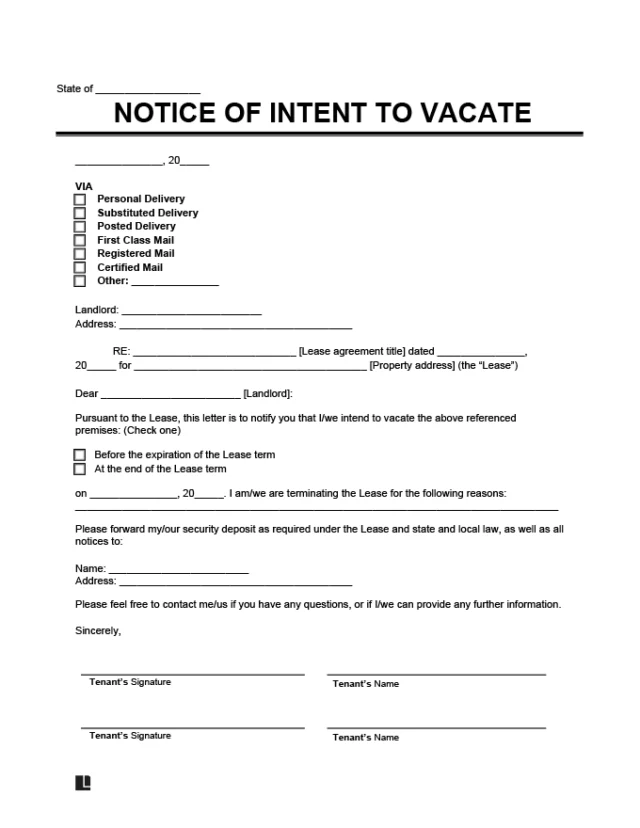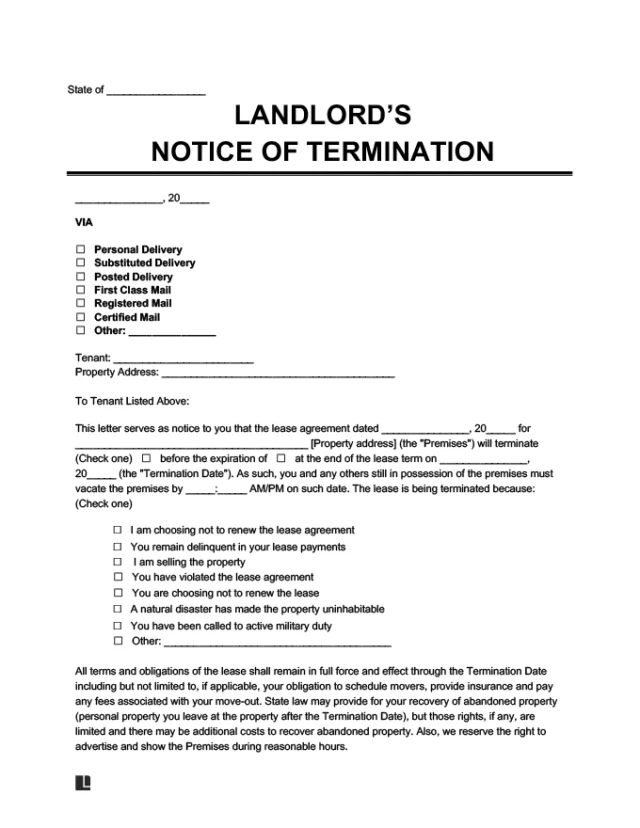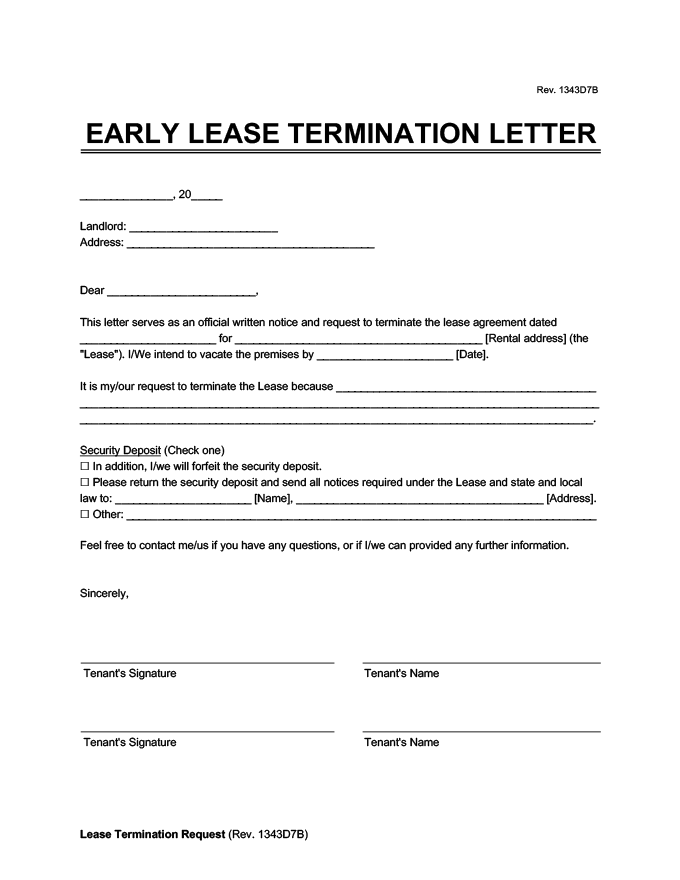What Is an Early Lease Termination Letter?
An early lease termination letter is a formal written notice that a tenant provides to a landlord to end a lease before the official end date. While not always required by law, sending a letter is highly recommended because it:
- Documents your intent to move out early
- Helps avoid misunderstandings or disputes about notice or responsibilities
- Can support your case if penalties or legal issues arise
Even if your lease doesn’t ask for one, having a written termination letter can make the process smoother and more professional. It’s especially helpful if you need to negotiate terms, request a refund of your deposit, or avoid penalties.
When Do You Need an Early Lease Termination Letter?
You may need an early lease termination letter when unexpected circumstances make it impossible for you to remain in the property until your lease ends. Common situations include:
- Relocation for work, school, or medical care: A new job, college, or transfer, or long-term medical treatment may require moving to another city or state.
- Financial hardship: If a loss of income makes rent unaffordable, a written letter helps you formally request early release from your lease.
- Lease violations by the landlord or tenant: You may be able to terminate a lease early if your landlord fails to maintain safe and habitable living conditions, which is known as the warranty of habitability. For example, tenants in New York are protected under the New York Real Property Law § 235-b, which requires landlords to maintain safe housing conditions.
- Military service: Active duty service members can terminate a lease without penalty under the Servicemembers Civil Relief Act (50 US Code § 3955).
- Domestic violence: Many states allow tenants experiencing domestic violence to end a lease early with proper documentation, such as a police report or a court order. For instance, in California, tenants can legally terminate a lease without penalty if they or a household member is a victim of domestic violence, sexual assault, stalking, human trafficking, or elder abuse (California Civil Code § 1946.7).
How to Write a Termination Letter to Break a Lease Early
Writing a clear and respectful letter can help you legally terminate your lease without adding conflict or penalties. Use the steps below to structure your letter:
Step 1 – Start With Basic Contact Details
Include your full name, the rental property address, and the landlord’s or property manager’s name and address. Date the letter clearly, as this will serve as your official notice of termination in most states.
Step 2 – Include Lease Information
List the lease start date and the exact date you are planning to move out. This ensures clarity and helps avoid disputes about the notice period.
Check your lease agreement to confirm how much notice period you need to give. Typically, you are required to provide at least 30 or 60 days’ notice.
Step 3 – State the Reason for Termination
In your early termination of lease letter, briefly explain why you’re ending the lease early. This isn’t always legally required, but being transparent helps maintain goodwill and can support your legal rights.
If you’re ending the lease due to a roommate conflict, include a copy of your roommate agreement and explain any violations if applicable.
Step 4 – Provide a Move-Out Date
Clearly state when you plan to move out and return the keys. This lets your landlord begin re-entering the unit and schedule a final walkthrough.
Step 5 – Request Security Deposit Return
Request the return of your security deposit, unless your lease or actions indicate otherwise. For example, in California, landlords are required to return the deposit within 21 days of move-out, minus any lawful deductions (California Civil Code § 1950.5).
Step 6 – Provide Forwarding Address
Include your new mailing address, email, and phone number. This lets your landlord:
- Return your security deposit
- Send you a final itemized deductions list if required
- Contact you with any follow-up questions or legal notices
Step 7 – Request a Move-Out Inspection
Ask for a final walkthrough of the property. This protects you from unfair damage claims and allows you to resolve issues. Consider using a moving checklist to stay organized and on track.
What to Do After Writing Your Early Lease Termination Letter
Once you’ve written your letter, follow these steps to protect your rights and ensure a smooth transition:
- Send it in writing: Deliver the letter by certified mail with a return receipt, hand-deliver it (with a signed copy), or email it if your lease allows. Always keep a copy for your records.
- Confirm delivery: Some states require proof of delivery to start the notice period. Check your lease and local laws.
- Wait for a response: Your landlord may contact you to confirm the move-out date, schedule an inspection, or discuss next steps.
- Prepare for move-out: Clean the unit, take photos of its condition, and complete a final walkthrough to avoid disputes over your security deposit.
Are There Penalties for Breaking a Lease Early?
Yes, breaking a lease early can lead to financial consequences unless your reason is legally protected or allowed under your lease terms. Common penalties include:
- Early termination fee: Many leases charge one or two months’ rent as a flat fee or for ending the agreement early.
- Loss of security deposit: You may forfeit your security deposit if you break the lease without cause or if you damage the unit.
- Ongoing rent: In some cases, you may owe rent until the landlord finds a new tenant, unless your lease says otherwise.
- Legal action: A landlord can sue for unpaid rent or damages if the termination of the lease is deemed to be in violation of its terms
Do State Laws Affect Early Lease Termination?
Yes, early lease termination rules differ by state, and your rights depend on both local laws and the terms of your lease.
- Alabama typically requires at least 30 days’ written notice to terminate a lease early, unless otherwise stated in the lease (Alabama Code § 35-9A-441).
- Utah allows early termination in cases involving domestic violence or if the property is unsafe (Utah Code § 57-22-5.1).
- Oklahoma allows early lease termination with 30 days’ written notice for month-to-month tenancies and in cases involving domestic violence, sexual violence, or stalking (Oklahoma Statutes §41-111).
Always check your local landlord-tenant laws and lease agreement for exact requirements.
Sample Early Lease Termination Letter
View a sample early lease termination letter template below to help you notify your landlord that you’re ending your lease early. This early lease termination letter from a tenant to a landlord outlines all the key sections that should be included. Then, complete our guided questionnaire to customize your letter and download it in PDF or Word format.






